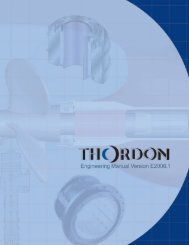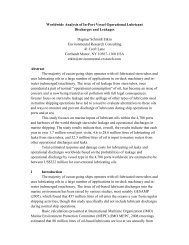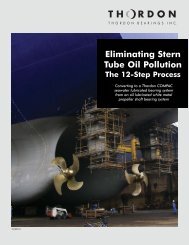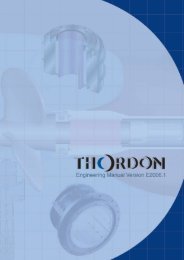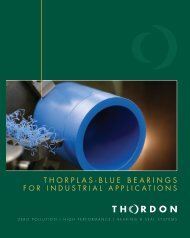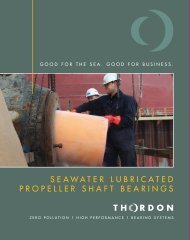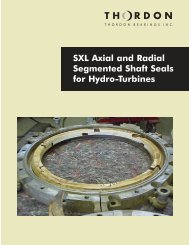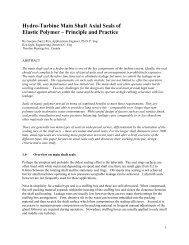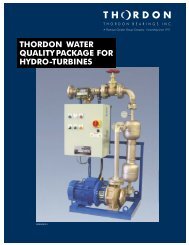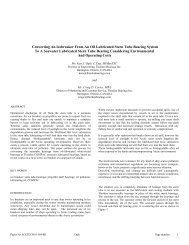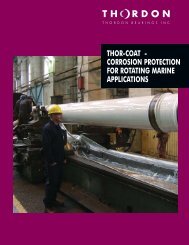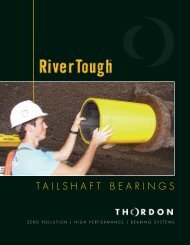An Oil to Water Conversion of a Hydro Turbine ... - Thordon Bearings
An Oil to Water Conversion of a Hydro Turbine ... - Thordon Bearings
An Oil to Water Conversion of a Hydro Turbine ... - Thordon Bearings
- No tags were found...
You also want an ePaper? Increase the reach of your titles
YUMPU automatically turns print PDFs into web optimized ePapers that Google loves.
Stainless Steel Shaft Sleeve:With the original bearing operating with oil lubrication there were no problems from corrosion <strong>of</strong>the carbon steel shaft. However with water lubrication, corrosion <strong>to</strong> the shaft is a concern. If theshaft begins <strong>to</strong> corrode in way <strong>of</strong> the bearing or the segmented seals, the corrosion couldaccelerate the wear <strong>of</strong> the <strong>Thordon</strong> SXL components. A new stainless steel liner was installedon<strong>to</strong> the shaft in way <strong>of</strong> the bearing and segmented seals. The liner was supplied as split andwelded <strong>to</strong>gether on site. The OD <strong>of</strong> the liner was final machined in place <strong>to</strong> a predetermineddimension.Operating Conditions:The bearing was designed <strong>to</strong> operate on the following unit, under the listed conditions:ManufacturerPel<strong>to</strong>n <strong>Water</strong> WheelYear Built 1927TypeVertical, FrancisRunner Diameter 5’‐10”Horsepower 13,750Rated Flow (cfs) 550Gross Head (ft) 197Speed (rpm) 257Shaft Sleeve Outside Diameter (in) 14.75The cus<strong>to</strong>mer also knew that the head cover was normally in a partial vacuum condition but fullinformation was not available at the time <strong>to</strong> indicate the exact amount. Packing from the existingstuffing box had long since been removed and not replaced. However due <strong>to</strong> powerhouselocation, partway up a mountain, there was no major concern <strong>of</strong> backflow in<strong>to</strong> the powerhouse.When installation was complete and the turbine was restarted, it was noticed that even at therecommended water flow, there was no water leakage past the seals in<strong>to</strong> the collection basin. Itwas at this time that the vacuum issue became apparent. The initial reaction was <strong>to</strong> increase thewater flow <strong>to</strong> as much as 50% above the recommended value but this still did not correct theproblem. As a temporary measure, it was recommended that a secondary water supply beprovided <strong>to</strong> the basin in order <strong>to</strong> reverse flow through the segmented seals for cooling and <strong>to</strong>avoid overheating.Some flow and friction loss calculations determined that the void in front <strong>of</strong> the tapered keysetwas almost equivalent <strong>to</strong> all the other bearing grooves added <strong>to</strong>gether. Several options wereconsidered <strong>to</strong> cure this problem. A possible design feature <strong>to</strong> ensure the bearing and the sealswere continuously flooded was <strong>to</strong> add a restric<strong>to</strong>r ring under the bearing. This option wasconsidered and evaluated as a possible solution. Different materials were also considered for useas the restric<strong>to</strong>r ring. The downside <strong>of</strong> this option was that very high pressures are required <strong>to</strong>ensure the required amount <strong>of</strong> water flow through the typically tight clearance <strong>of</strong> such rings. Theminimum recommended water flow for <strong>Thordon</strong> polymer bearing materials in a main guideapplication with similar clearances is 2gallons per minute per inch <strong>of</strong> shaft diameter. In thisparticular application the minimum recommended flow rate was ~30gallons per minute. After7



